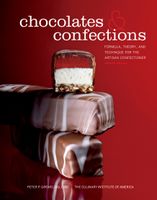Label
All
0
Clear all filters
Appears in
By Peter Greweling and Culinary Institute of America
Published 2007
Like fondant, fudge is a system of sugar crystals surrounded by saturated syrup. Fudge is made more complex by the addition of fat, dairy products, and flavoring ingredients. Each of the ingredients in a fudge formula plays a vital role in determining the final texture, flavor, appearance, and shelf life of the product. Fudge formulations are a delicate balance of all the components, and relatively small variations in the quantities of the ingredients tend to cause profoundly different results. Due to its crystalline nature, fudge is not a hygroscopic product. On the contrary, with its relatively high equilibrium relative humidity (ERH), fudge left exposed to air has a tendency to dry out. It is therefore necessary to take steps to prevent moisture loss. After it is cut, fudge should be wrapped, packaged, or enrobed as soon as possible. While it can produce excellent confections and is highly effective in preventing moisture migration, dipping or enrobing fudge in chocolate is not common, in part because of fudge’s inherent sweetness and its origins as a simple, unadorned American confection. Still, enrobing fudge in chocolate can create textural and flavor contrast and unique pieces.
Part of
Advertisement
Related Recipes
-
-
-
-
Related Reference
-
-
-
-
Advertisement
The licensor does not allow printing of this title




